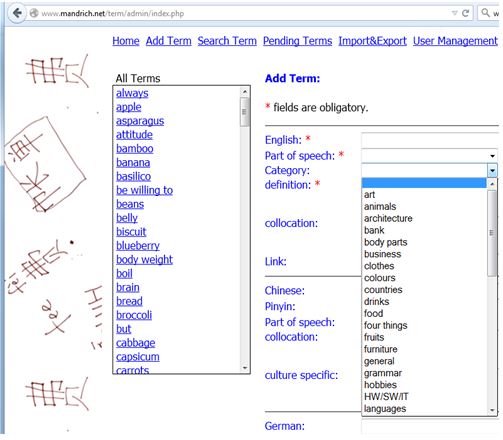Semantic Knowledge Management
Enhancing learning through Semantic Knowledge Management
With semantic knowledge management practices in language learning I refer to exercises and activities whose purpose is the organisation of concepts into semantically organized data. This group of exercises includes the ordering of substantives into semantic related categories (e. g. fruits, animals, mammals), the building of contrary pairs (good vs. bad) or the creation of topic maps.
Efficient and effective vocabulary acquisition has been at the center of my language learning experiment that I conducted at the East China Normal University in Shanghai from January 2009 to Dezember 2010. During this time I architected a personal learning path and developed ad-hoc exercises to exploit the brain’s natural mechanism of selection and organization of words into semantic networks.
Through the use of a terminology database learners get practical experience in the management of semantic relations and the creation of taxonomies. The describing fields of the terminology database enables users to add different information to the lexicon. These include grammatical categories (e. g. part of speech, gender), semantic relations (hyponymy, hypernymy) or subject matter information (politic, geography, economy, science).

Semantic Knowledge Management for Enhancing Learning – Attributes of a personal terminology database
Enhancing Learning through Semantic Knowledge Management
Through the use of semantic knowledge management practices for enhancing learning learners:
- learn to select and manage preferred lists of terms;
- work with grammar and semantic categories, e. g. assigning terms to part of speech, finding synonyms, hypernyms, hyponyms or contraries;
- manage personal taxonomies (e. g. subject field taxonomy) that can be used in the blog for categorizing postings and tags;
- reflect – through contrastive analysis – about differences among languages and cultures ;
- create ad-hoc exports from the collected linguistic data that can be further processed and used in mobile applications (e.g. for the creation of personal flashcards or language games).
Enhancing Systemic Thinking through Semantic Knowledge Management
In this personal learning environment, learners develop more than grammar correctness and writing competency. By working with semantic knowledge management practices learners increase meta-cognitive faculties and systemic thinking. By blending semantic knowledge with personal experience learners reinforce semantic and episodic memory. By taking a higher responsibility for their learning, learners transform the complex activity of learning in an enjoyable and rewarding challenge.
Reducing learning time through Semantic knowledge Management
The result of this experiment was the development of a learning process that focuses on the systematic acquisition of semantic knowledge as a mean to develop mature thinking about language structures and expressivity in inter-linguistic perspective. Using a terminology database for learning the lexicon of the Chinese language, I was able to acquire proficiency in the Chinese language within two years, considerably reducing the time needed in a formal academic path (five years).
Visit my facebook account I Speak Chinese!